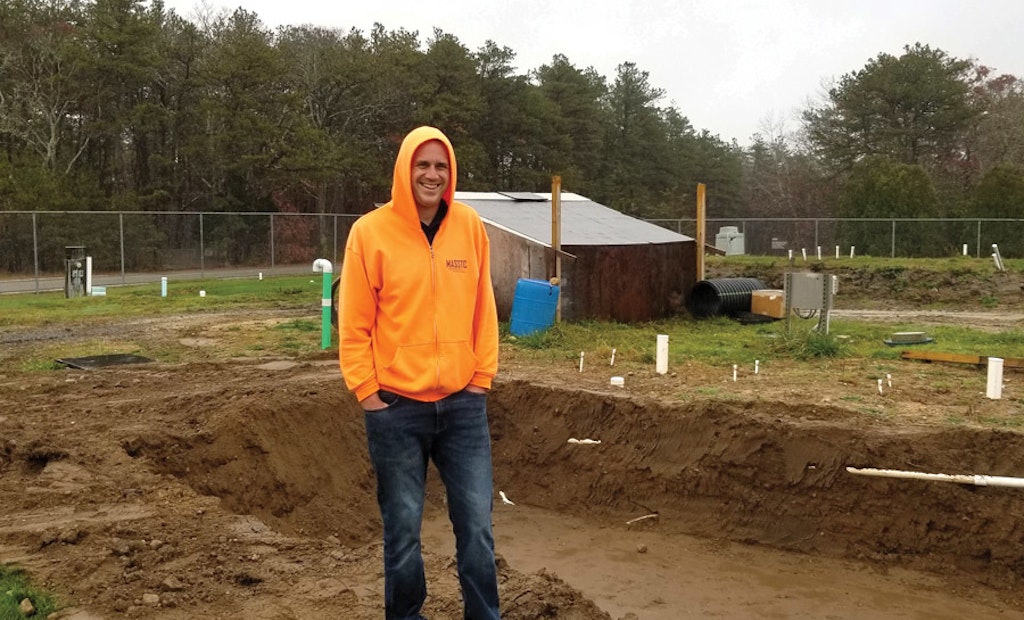
Brian Baumgaertel, director of the Massachusetts Alternative Septic System Test Center, is shown at the site of phosphorus project. (submitted photo)
All across the country, people interested in water quality have been talking about nitrogen, where it’s coming from and how to control it. But there is another nutrient just as important but less often in the spotlight, and now it’s due for attention.
“Phosphorus has been one of those issues kind of sidelined by nitrogen,” says Brian Baumgaertel, director of the Massachusetts Alternative Septic System Test Center. “There aren’t a whole lot of technologies looking to remove phosphorus.”
On Cape Cod, where the center operates as a division of the Barnstable County Health Department, phosphorus is a problem along with nitrogen. “A lot of our ponds have some increased eutrophication issues in the last five to 10 years,” he says.
Pushing for progress
Freshwater bodies are especially vulnerable to phosphorus pollution. Baumgaertel says science has found phosphorus is typically the limiting nutrient in freshwater, whereas algae are usually nitrogen-limited along the ocean shore. Phosphorus has been a problem around the country, too, he says, for example as the cause of widely publicized algae blooms in the Great Lakes.
As a result of renewed public attention, he says, there is a push to solve the phosphorus problem. The center is using that attention as the starting point to experiment with new phosphorus-removal technologies in the hope that one or more can be added to the tools wastewater professionals use. Massachusetts currently allows only two such technologies, he says. Another goal of the experiments is to gather performance data on technologies already in the marketplace.
Phosphorus on the cape comes from two main sources, Baumgaertel says. Depending on which study you read, he says, septic systems could account for as little as 4% of the problem or as much as 60%. The other contributor is fertilizer and linked to that is land use.
“A lot of people who live around ponds like to cut down all the trees from their house to the waterline so they have the nice view,” he says. But people replace the trees with lawns and fertilize them. Trees take in a lot of phosphorus, he says, and once they’re removed the lawns generate phosphorus-containing runoff that flows into the water and feeds algae.
Finding the tools
Another goal of the center’s phosphorus project is to provide hard numbers that help show what the sources of phosphorus pollution are on the cape and what difference various technologies can make, he says.
Remedies previously tried on the cape include adding iron to ponds to precipitate phosphorus, and using SolarBee solar-powered mixers to circulate water as a water quality improvement tool. Seven or eight SolarBees were installed on one pond, and they seemed to work for several years, but now pond algae is growing vigorously again, he says.
Baumgaertel is new to his position, and he says the phosphorus removal project first came up during a talk with George Heufelder, the center’s former director, about what the center’s next steps should be. Heufelder had already contacted vendors of phosphorus technology and asked for donations for an experiment to install equipment in the field on Cape Cod.
“Most of the vendors really jumped at the opportunity,” Baumgaertel says.
Waterloo Biofilter, Geomatrix, Oakson, Fuji Clean USA and Norweco donated equipment, he says. Their donations were worth about $150,000 and also counted toward the matching funds required for a U.S. Environmental Protection Agency 319 grant of about $200,000 that is funding the work.
Real-world tests
Technologies will be installed at homes on the cape. Test sites are focused in one area, primarily to make sample collection easier, he says. Hopefully, some sites will also be near ponds and will be year-round residences to test the effects on freshwater, he says.
The EPA grant provides enough money to give a $5,000 subsidy to five homeowners. Equipment promised by vendors will probably be enough for another five to seven homes, Baumgaertel says.
Installations were on track to happen in 2020, but the COVID-19 pandemic stalled those plans.
“We have some willing folks lined up and some candidate sites identified,” he says.
EPA 319 grants last typically for two years, but the agency has also been willing to extend them, he says. At minimum the center is planning to track the test systems for 12 to 18 months, he says.






